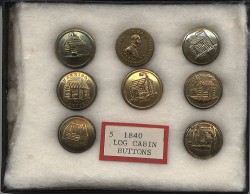
Photo thanks to: Cornell University
A friend has a large collection of campaign buttons, dating back to William Henry Harrison (US president for only 31 days in 1841).
When Antiques Roadshow came to town, she eagerly brought some of her collection in for appraisal, hoping to be told her treasured buttons were worth lots of money.
It turns out that they weren’t.
Why didn’t this work?
Because collectors want something very particular. Not all campaign buttons, but campaign buttons for Republicans from Pennsylvania. Or, buttons from Barack Obama’s campaign for president.
If you’re an Obama guy, Clinton buttons won’t do. Certainly not George W. Bush buttons.
Her selection was too broad to interest avid collectors who want one thing and one thing only, and will buy anything and everything that fits that particular niche.
How does this apply to marketing?
Be specific
Try aiming your marketing and your services toward your own niche collectors: the people who want exactly what you do (accountants who need web sites, dry cleaners who want flyers designed, or musicians who want web videos).
Build anticipation
People are drawn to Antiques Roadshow by the possibility of finding great riches from something they bought at a yard sale for $5. Give out little snippets about what you’re up to. Make people curious.
Demonstrate success
Show other people succeeding after following your advice or using your services. Include testimonials and case studies. Make a video or two showing happy clients.
Fill a void
I came across someone who collects old Burry’s cookie boxes (a company that went out of business years ago). To a cookie box collector, the price doesn’t matter. What does matter is filling any possible hole in his collection, or finding something extraordinarily rare that other collectors can’t get. That’s not just the joy of acquisition, it’s the joy of exclusivity.
Give people something they can’t get elsewhere; such as a project progress dashboard, or blog posts from videos.
What do you think? Is there something you’re doing that nobody else does? What is it? Share your story.

